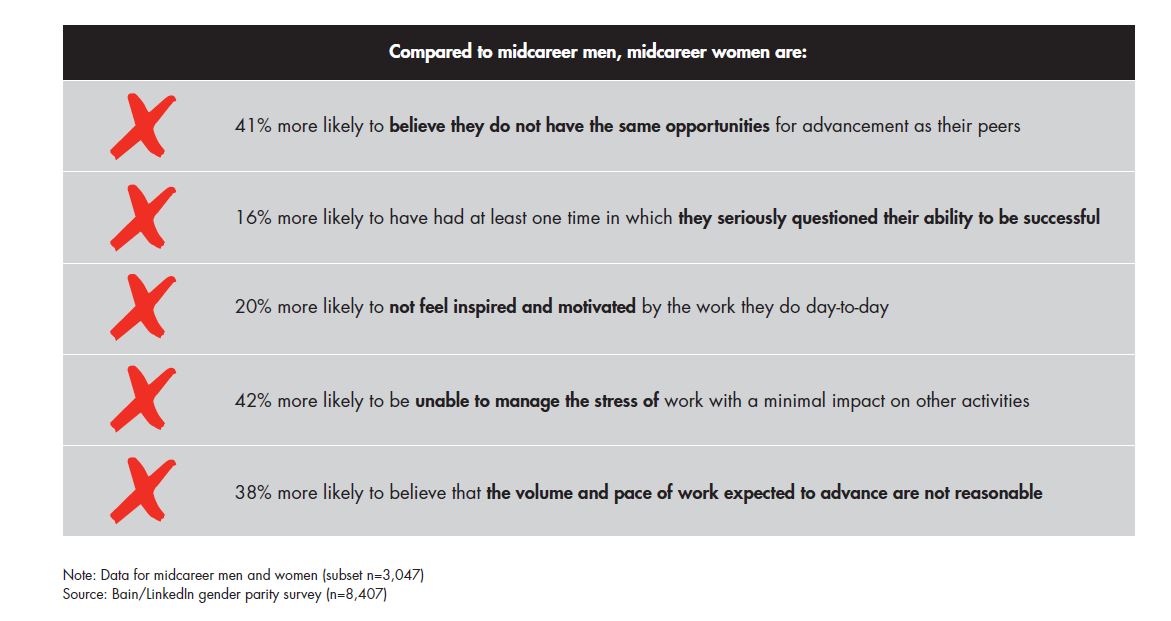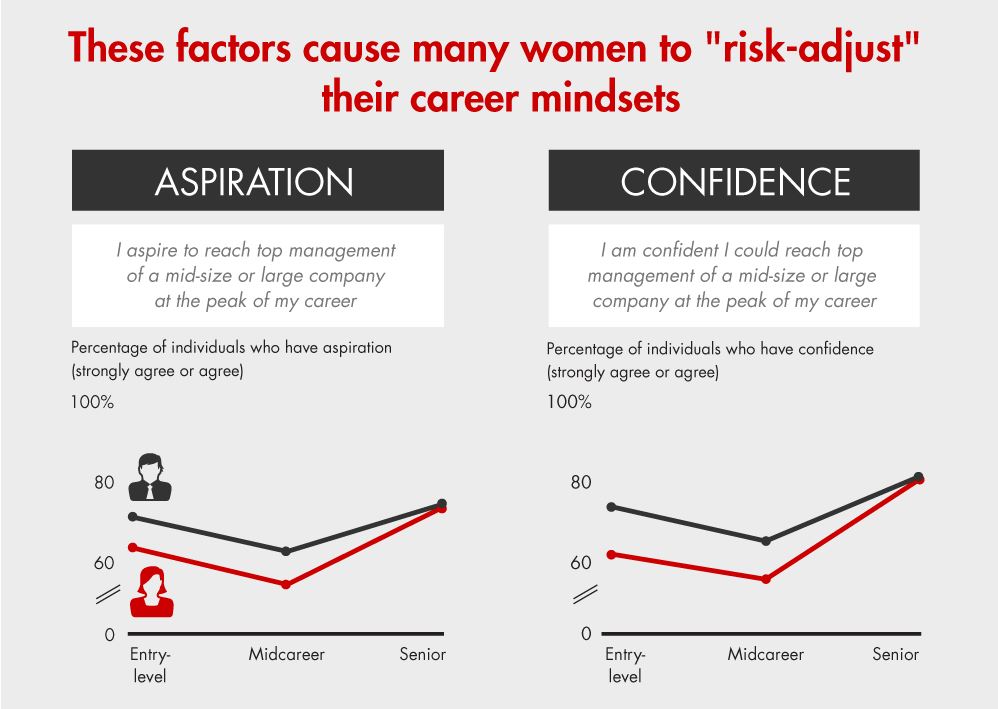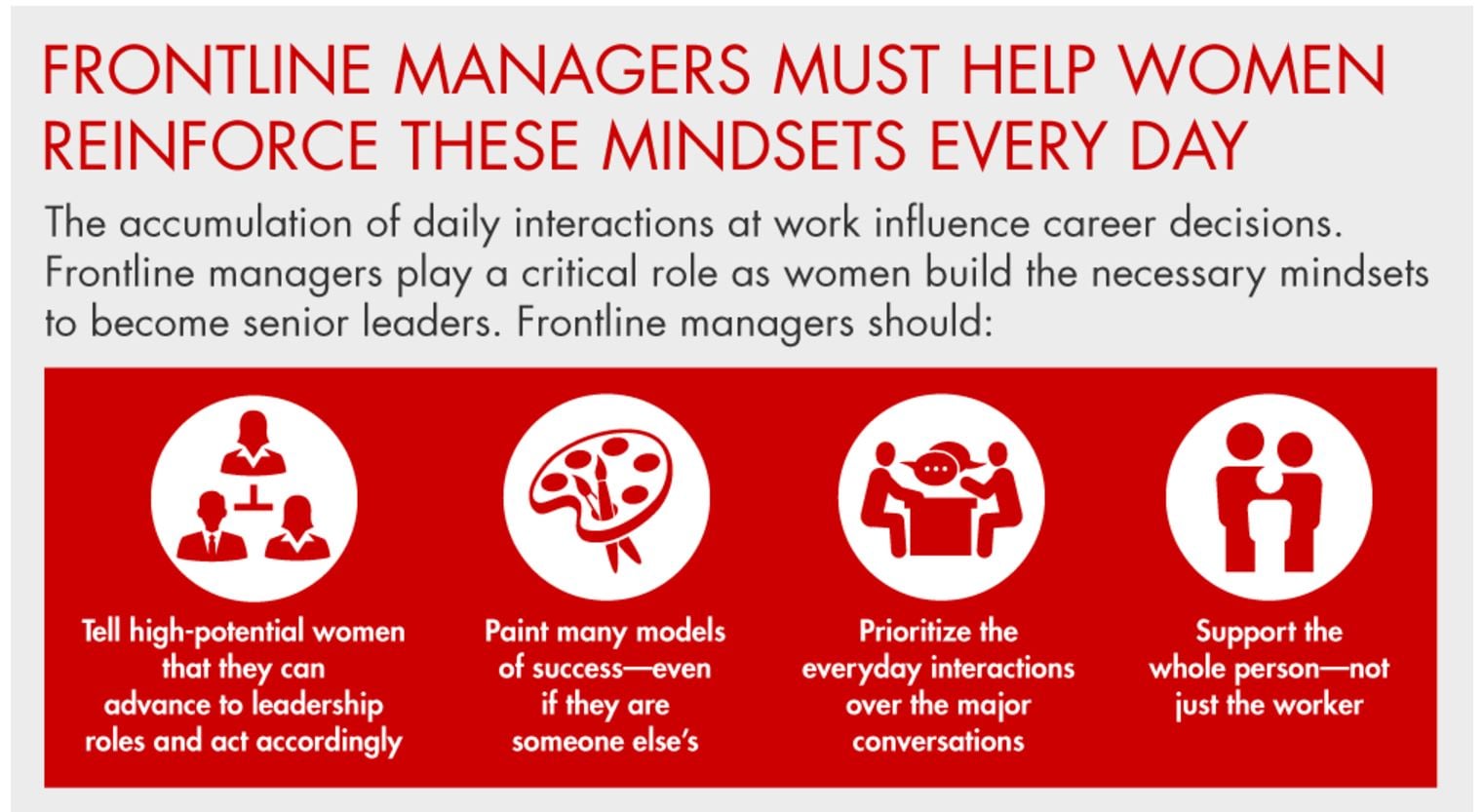Despite outnumbering male college graduates and making up 40 percent of the classes at several top MBA programs, women represent just 25.1 percent of senior managers and executives at S&P 500 companies and a paltry 4.4 percent of CEOs, according to Catalyst, a nonprofit organization promoting inclusive workplaces for women. What gives?
Leading consulting firm Bain & Company partnered with LinkedIn in late 2016 to answer that very question—and come up with recommendations for how to effect change. Together, Bain and LinkedIn conducted a survey of 8,400 men and women on LinkedIn who work for U.S. companies and hold at least a bachelor’s degree. They asked this group—which included everyone from entry-level employees to top leaders at firms spanning all major industries—about their career aspirations and how confident they felt in their ability to reach the executive level.
Analysis of the results revealed that though men and women have similar aspirations when they graduate from college, women’s aspirations and confidence dropped significantly a few years into their careers.
The Terrain Is Different for Women
“What struck us most was the sense that the terrain is different for women versus men,” explains Bain’s Julie Coffman, a Chicago-based partner and head of the firm’s Global Women’s Leadership Council. Indeed, the report that grew out of the survey, entitled “Charting the Course—Getting Women to the Top,” compared career progression to mountain climbing. “Women and men today have the same climbing ability, even if they demonstrate different strengths at different times,” it read. “The gender gap in the C-suite persists because external factors create a more difficult path to the top for women—one with more strenuous terrain requiring more energy and perseverance. That, in turn, affects women’s aspiration and confidence over time.”
The path that women must climb is made more difficult by both overt and unconscious bias within the workplace and unequal pressures at home, according to the report. At work, this bias can take the subtle form of comments on a performance review questioning a woman’s career commitment to exclusion from an all-male golf outing where informal mentorship takes place. At home, meanwhile, the survey found that 61 percent of mid-career women have a spouse or partner who is pursuing a more intense or equally intense career, as compared to 38 percent of mid-career men. And of those with children, mid-career women were almost six times more likely to be the primary parent.

“Women are just living in a different reality,” says Coffman. “It requires a lot of energy and perseverance to overcome those added obstacles.” For many women, the steady stream of obstacles erodes confidence and aspiration—leading them to question or rethink their career goals. At mid-career, when employees are most likely to face the choice of pursuing leadership positions or opting out, the gaps in men and women’s aspiration and confidence are greatest. Just 56 percent of women aspire to a senior leadership position, compared with 64 percent of men, and 57 percent of women feel confident they can get there, compared with 66 percent of men, according to the survey.

Frontline Managers Can Make a Difference
Just as it would develop recommendations for a client facing a business challenge, Bain developed recommendations to help its own managers contend with the fact that women must navigate more difficult terrain than their male counterparts.
“As every climber knows, having a seasoned guide—someone who knows the different routes and the terrain—can make all the difference,” read the report. “In the workplace, it’s the frontline managers who walk next to women every day and can exert significant influence on their development as leaders.”
Bain developed four concrete actions frontline managers can take to help prevent flagging aspiration and confidence among mid-career women. These recommendations came from common themes that emerged in an analysis of survey participants’ responses to a series of detailed questions about workplace dynamics.

First, tell women they can succeed and back it up with action, counsels Coffman. “Take the time to say, ‘I believe you are going to do great at this company,’” she says. “We think it’s a big deal, this idea of sponsorship and having senior people be more explicit about their potential.”
Second, paint many pictures of success. “When I started at Bain 27 years ago, there were fewer senior women at the firm, and if you didn’t feel like you could be like them it was a little scary,” says Coffman. Leaders need to be thoughtful about how they showcase what success can look like at their companies—portraying extroverts as well as introverts, part-time as well as full-time employees, people who move from one big multinational account to another and others who stick with the same account over many years. “The more that women can look up and see a variety of ways to make it to the top, the better,” adds Coffman.
For her part, Coffman learned to take conference calls from her son’s baseball games or on her way to the grocery store. “I can’t tell you the number of calls I have done from my son’s games, which are slow moving anyway,” she says. “By being transparent about those things, I can show others how to create opportunities.”
Third, give frequent, informal praise and feedback rather than saving it up for annual performance reviews. It can be easy, Coffman acknowledges, especially when you’re running a team, to save up feedback for major milestone-type interactions. But she encourages the opposite. “More routine, everyday types of interaction can be helpful—it’s in these little moments where someone’s confidence can be picked up just when it might otherwise lag,” says Coffman.
Finally, support the whole person, not just the worker. There’s value in being aware of an employee’s personal situation, notes Coffman. Do they have kids at home? Are they going through a tough divorce? Caring for an ailing parent? “Think about how you tailor the way in which you work with them,” she advises. “When managers view the people who work for them as assets to be depleted, they miss out on important opportunities to cultivate talent.”
Of course, notes Coffman, there is nothing in these suggested actions that wouldn’t also be great for male employees. “We have a gap to close—and so our focus was on what seems to matter more for women—but who doesn’t want to be praised or sponsored?” she says.
Bain Tackles Female Retention Like a Client Problem

This latest survey with LinkedIn is one of several initiatives Bain’s GWLC has spearheaded since it was formed in 2009. “We were recruiting a fairly good number, but we were not retaining women at the rate we thought we should be able to given the talent base we had access to,” Coffman says. “Steve Ellis [then Bain’s worldwide managing director] really wanted us to take a harder look and treat it more like a client problem—to understand the root causes of gaps in women in leadership roles.” Coffman has chaired the council since it was created, examining the culture and practices within Bain as well as conducting outside research with partners to try to understand what is going on with women in companies writ large, she says. “We are trying to continually up our game.”
This latest research will be disseminated in a variety of ways, she says. First, Bain has created a presentation and is sharing it with partners in each of the firm’s more than 50 offices around the globe. “Between now and October, we are asking each office to devote time in a VP manager leadership meeting to sharing the research and facilitating a conversation around the everyday behaviors we can all commit to that will make it real for our people,” she says.
There are also plans to engage with specific groups as part of more detailed workshops. For example, every other year Bain hosts a Global Women’s Leadership Forum, and the next will feature a deeper dive about how women can thrive at Bain. “Our mission is not for women to survive, but to thrive,” says Coffman. “We think a thriving mindset is critical to being able to build aspiration and confidence.”
Finally, Coffman and others have been speaking externally about the findings—to the media as well as at conferences, alumni gatherings, and recruiting events. “We’re looking not only to get exposure that way but also just to get the dialogue going,” she says.
Client Firms Look to Learn from Bain
Chairing the GWLC is not Coffman’s main job at Bain—she is a full regular partner in the firm’s healthcare practice. But clients, aware of her role in the GWLC, have turned to her on many occasions seeking guidance on the problems they face with female retention. “I have spent a fair amount of time in the last five years being introduced to the chief diversity officers at our client firms because they are interested in our journey,” she says. She has also spoken at a number of events and forums for different groups of senior women leaders. “What I would love to do personally—and I have talked about this openly—is to continue to try to be a resource for our most important clients.”
To read the full report, “Charting the Course—Getting Women to the Top,” click here.





